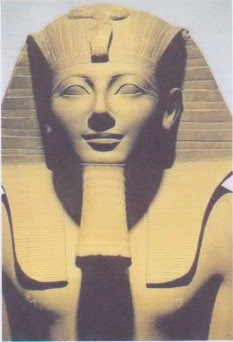The FIFTEENTH CENTURY BCE (1499-1400) is the century of the Royal Egyptian family of Tuthmosis, those born in truth of the great god Thoth. Their name can be spelt in various ways, changing down the years as experts experience increased, and the ancient language became better under stood. Variations on the name are Thothmes, Tuthmosis, Thuthmosis, Thutmos.
1492 TUTHMOSIS II son and heir to Tuthmosis I and Mutnofret. Tuthmosis II died in 1479 after nearly 14 years on the throne. Tuthmosis II and his royal concubine Isis, gave birth to a son destined to become Tuthmosis III. (100. 175)
The father of this pharaoh, TUTHMOSIS I succeeded to the Egyptian throne after marrying Ahmes. From their union is born Hatshepsut. Tuthmosis I is a prince of Thebes and worshipper of Amon. He initiated an era of renewed temple building by increasing the size of the temple of Karnak and adding a place of worship for Montu, god of war. At the time this was the only Amon temple of any importance in Thebes. (80. 49.)
The first appearance of a collection of funeral texts called the ‘Book of What is in the Underworld’ (Am Dwat) is found on the walls of the burial chamber of Tuthmosis I, ancestor of the future rebel king Akhenaten. Tuthmosis I inaugurated the tradition of burial in the Valley of the Kings, and the mortuary temple now became separated from the tomb. (175)
1479 HATSHEPSUT daughter of Thutmose I and Queen Ahmose/Ahmes was suckled by the wet nurse Inet also known as Sitre. To her brother Tuthmosis II, Hatshepsut has a daughter, Neferure. Hatshepsut is sometimes depicted as male and sometimes as female in form thus reflecting the polarities of life upon which Egyptian philosophy is based. As a female king/pharaoh one of her titles was ‘God’s Wife’ and as such she participated in or led temple rituals. In the second or third year of her co-regency, Hatshepsut had herself crowned as king taking the titular: Maatkare (‘Maat is the ka of Ra’), Khnemet-Ameun-Hatshepsut (‘She who embraces Amun, the foremost of women’) Before the establishment of the ‘Valley of the Queens’, Hatchepsut’s tomb is located in a lonely and inaccessible ravine, high up in the face of the cliff, facing west and overlooking the Nile Valley. From this position, the autumn October sun threw its last beams right into the mouth of her tomb. (9) (108) (175) Hatshepsut is the proposed pharaoh’s daughter who rescued and raised the infant Moses (60). However, there is much confusion and debate over the possible dates of Moses and this is only one possibility.
Pharaoh Hatshepsut
1458 THUTMOSIS III is known as one of the greatest pharaohs of the Egyptian New Kingdom and of its 18th Dynasty. As step son of Hatshepsut, Tuthmosis is co-ruler with her, of the Egyptian Empire, until her death. Tuthmosis will take the throne in his own right from about 1458 and will reign for 33 years. He continues the development of temple architecture at Luxor, the location of the great Temple of Karnak and centre of the god Amun-Ra (or Amen-Re) This temple is the location of a king list recording 61 names. (49. 100. 175)
Tuthmosis III established an Egyptian Mystery School, which was to be the starting point of the future Brotherhood of the ‘Order of the Rosy Cross’. These ancient teachings, will be furthered by Pythagoras, Plato and their successors. The ascetic Egyptian Therapeutate will take the knowledge into Judaea, settling in Qumran in the days before Jesus. (131)
In the burial chambers of Thuthmosis III and the future Amenophis II, at Thebes, there are painted on the walls the hieroglyphs of ‘The Book of What is in the Dwat’. This book is displayed as though a huge papyrus has been unrolled around the walls, and tells of the nightly journey of the Great God Re through the regions of the twelve hours of the night. This is the nocturnal journey of genesis or metamorphosis taking place before the rebirth of the Sun god. (067) It seems to be an alchemical story of the transmutation of matter into higher consciousness, a cycle that takes place at regular intervals, for human and for cosmos.
Pharaoh Tuthmosis III



No comments:
Post a Comment